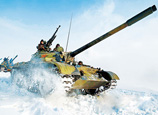
Experts of military colleges and academies become protagonists of exercises
The role of military colleges and academies in the military exercises in 2012 should not be ignored. The experts of the military colleges and academies even became the protagonists.
Two intermediate-level army command colleges, namely the Shijiazhuang Army Command College (SACC) and the Nanjing Army Command College (NACC) of the PLA, led their respective exploring roads.
The SACC firstly combined 19 military colleges and academies undertaking different tasks to carry out confrontation drill against a motorized infantry brigade of the PLA ground force, which was called by media as "cadet-soldiers fight against regular army". After that, instructors were organized to act the "blue army" to carry out confrontation drill against the cadets going to graduate, which was hailed as "cadets fight against instructors".
The NACC established the first large-scale "blue army" of military colleges and academies in the PLA's history to carry out successive confrontation drills against four divisions from the PLA ground force and PLA Air Force. The experts and professors of the military colleges and academies gave full play to their advantages in various aspects including foreign military study, command strategy and systematic application, causing a lot of trouble to the combat troop units which joined in the drill in turn. This type of command-organ confrontation mode and experience were also promoted throughout the PLA.
The fact that the experts and professors of military colleges and academies became the protagonists of the military exercises reflects two major changes: First, the military colleges and academies are accelerating their education transformation. Second, while the training of troop units is close to actual combat situation, the training in military colleges and academies is getting closer to troop units.
In 2012, the experts and professors of the two intermediate-level military colleges fully demonstrated their capabilities. In the "2012 Nanjing Confrontation", the leading organs of several main divisions organically carried out confrontation drills against the "blue army" of the military colleges and academies, but none of them had easy experience during the drill. In the "Red Star 2012" drill, the PLA intermediate-level commanders, who came to the military colleges and academies as cadets for advanced studies, were always in the defense positions.
It is becoming a common phenomenon for the military colleges and academies, combat troop units, scientific research institutes and training bases to respectively play their own vivid roles in military exercises.















 Busiest line in Beijing: Subway line 10 has reached a daily transportation of 1 million passengers on average
Busiest line in Beijing: Subway line 10 has reached a daily transportation of 1 million passengers on average


![]()
